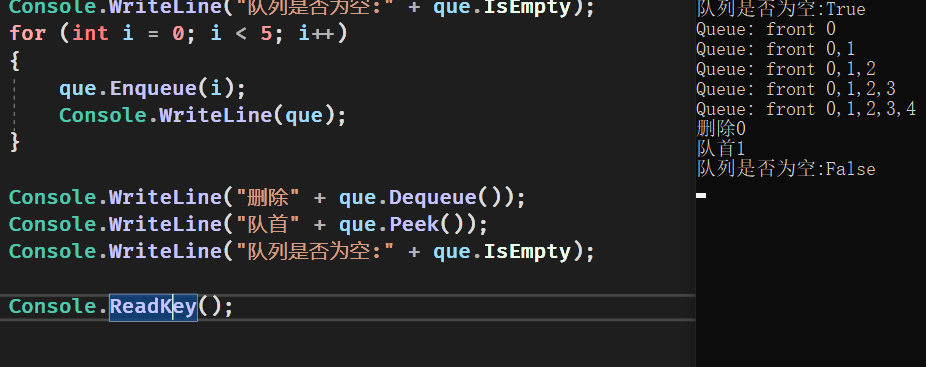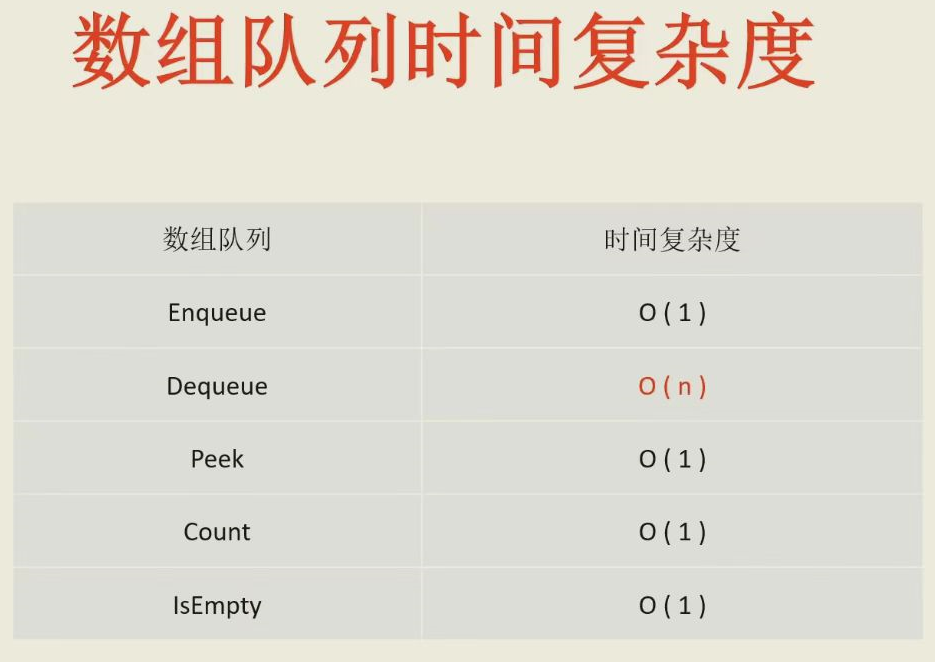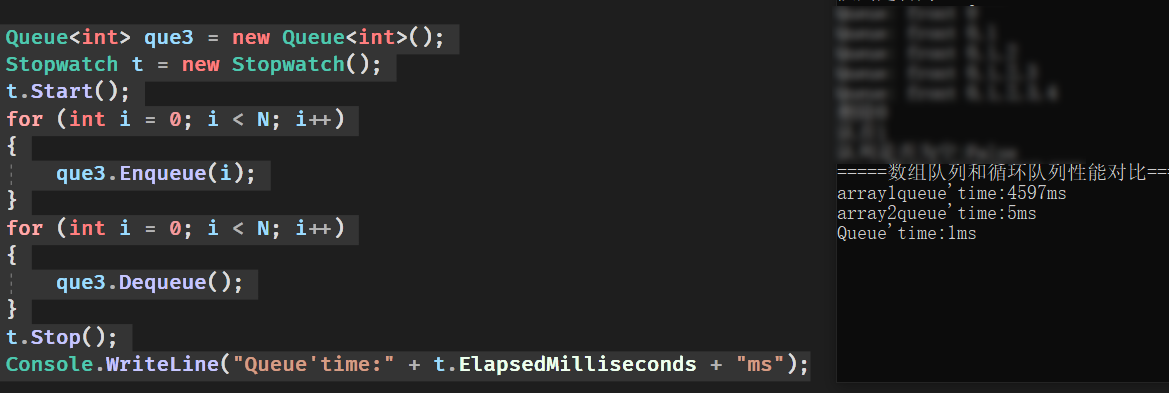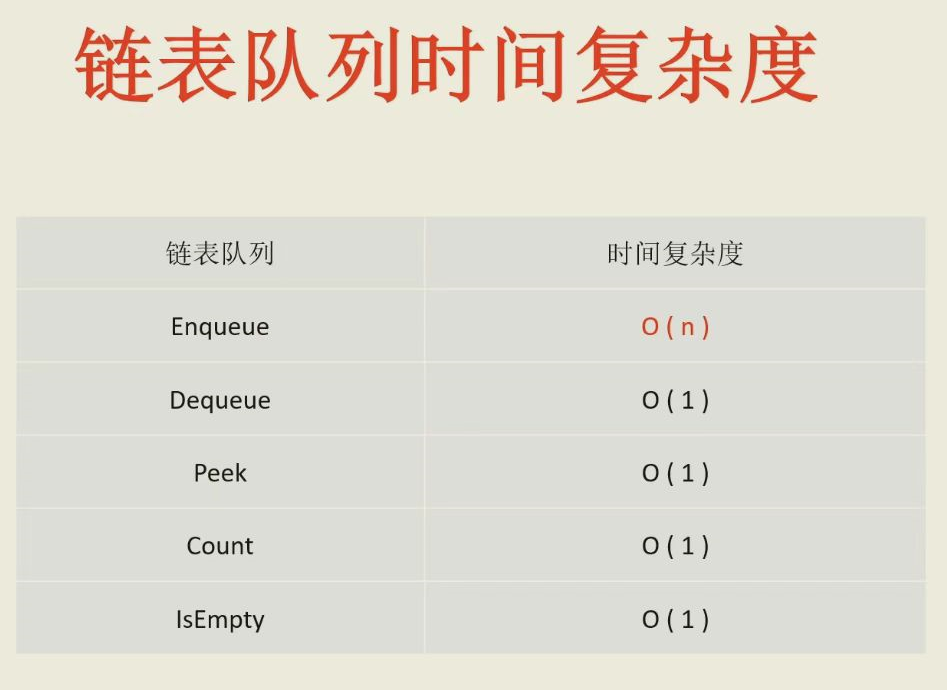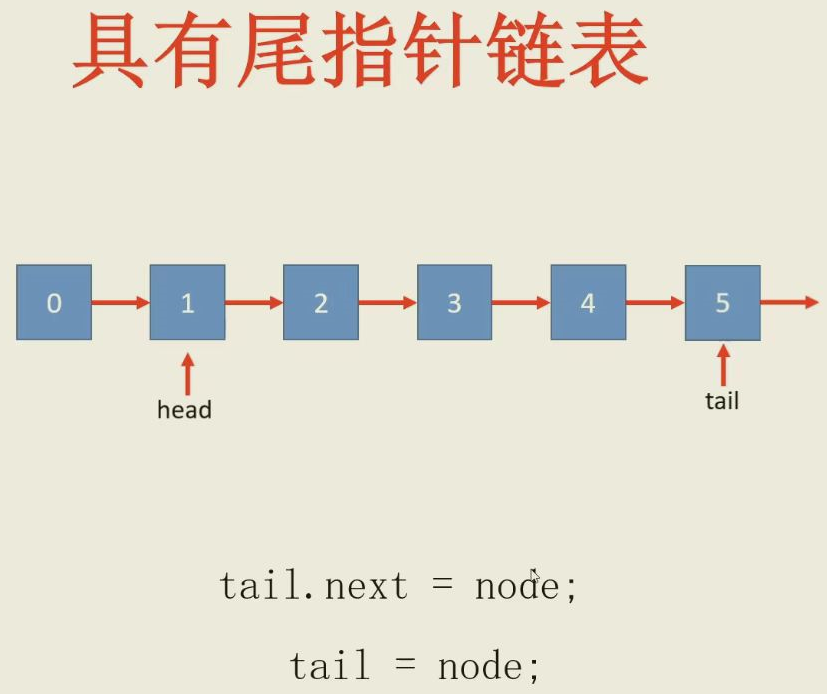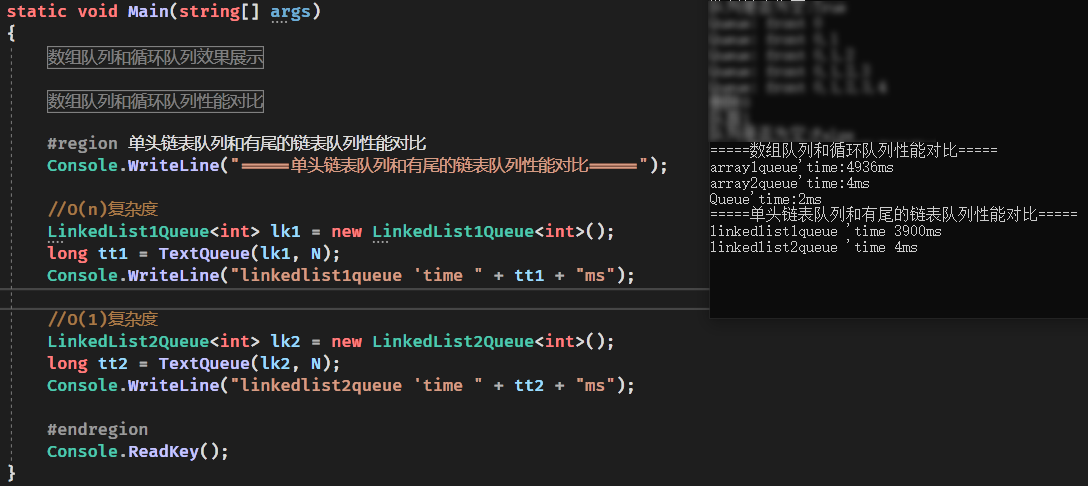队列(Queue) 数组实现队列 队列相关操作
void Enqueue(T t);//入队
T Dequeue();//出队
T Peek();//查看队首元素
int Count { get; }//查看元素个数
bool IsEmpty { get; }//查看队列是否为空
创建接口 创建接口IQueue
namespace AlgorithmTest10_ 队列Queue { interface IQueue <T > { void Enqueue (T t ) T Dequeue () ; T Peek () ; int Count { get ; } bool IsEmpty { get ; } } }
实现接口功能 新建**Array1Queue类,实现 IQueue**接口功能
using AlgorithmTest06_List;namespace AlgorithmTest10_ 队列Queue { class Array1Queue <T > : IQueue <T > { private SeqList<T> arr; public Array1Queue (int capacity { arr = new SeqList<T>(capacity); } public Array1Queue () { arr = new SeqList<T>(); } public int Count { get { return arr.GetCount(); } } public bool IsEmpty { get { return arr.IsEmpty(); } } public T Dequeue () { return arr.Delete(0 ); } public void Enqueue (T t ) { arr.AddLast(t); } public T Peek () { return arr.GetElem(0 ); } public override string ToString () { return "Queue: front " + arr.ToString(); } } }
效果展示 using System;namespace AlgorithmTest10_ 队列Queue { class Program { static void Main (string [] args { Array1Queue<int > que = new Array1Queue<int >(); Console.WriteLine("队列是否为空:" + que.IsEmpty); for (int i = 0 ; i < 5 ; i++) { que.Enqueue(i); Console.WriteLine(que); } Console.WriteLine("删除" + que.Dequeue()); Console.WriteLine("队首" + que.Peek()); Console.WriteLine("队列是否为空:" + que.IsEmpty); Console.ReadKey(); } } }
时间复杂度
可以看到按以上方法实现的出队时间复杂度为O(n)
所以我们需要循环队列 优化复杂度
循环队列 新建类**Array2**实现循环数组
实现循环数组 using System;using System.Text;namespace AlgorithmTest10_ 队列Queue { class Array2 <T > { private T[] data; private int first; private int last; private int count; public Array2 (int capacity { data = new T[capacity]; first = 0 ; last = 0 ; count = 0 ; } public Array2 () : this (10 public int GetCount { get { return count; } } public bool IsEmpty { get { return count == 0 ; } } public void AddLast (T t ) { if (count == data.Length) { RestCapacity(2 * data.Length); } data[last] = t; last = (last + 1 ) % data.Length; count++; } public T RemoveFirst () { if (IsEmpty) { throw new InvalidOperationException("不能数组为空!" ); } T ret = data[first]; data[first] = default (T); first = (first + 1 ) % data.Length; count--; if (count == data.Length / 4 ) { RestCapacity(data.Length / 2 ); } return ret; } public T GetFirst () { if (IsEmpty) { throw new InvalidOperationException("不能数组为空!" ); } return data[first]; } private void RestCapacity (int newCap { T[] newData = new T[newCap]; for (int i = 0 ; i < count; i++) { newData[i] = data[(first + i) % data.Length]; } data = newData; first = 0 ; last = count; } public override string ToString () { StringBuilder res = new StringBuilder(); for (int i = 0 ; i < count - 1 ; i++) { res.Append(data[(first + i) % data.Length] + "," ); } res.Append(data[(first + count - 1 ) % data.Length]); return res.ToString(); } } }
循环数组扩容 新建一个newData[],容量更大,将旧data[]数组中的first下标移到newData[0]完成扩容。
private void RestCapacity (int newCap{ T[] newData = new T[newCap]; for (int i = 0 ; i < count; i++) { newData[i] = data[(first + i) % data.Length]; } data = newData; first = 0 ; last = count; }
重写ToString() public override string ToString (){ StringBuilder res = new StringBuilder(); for (int i = 0 ; i < count - 1 ; i++) { res.Append(data[(first + i) % data.Length] + "," ); } res.Append(data[(first + count - 1 ) % data.Length]); return res.ToString(); }
实现接口功能 创建Array2Queue
namespace AlgorithmTest10_ 队列Queue { class Array2Queue <T > : IQueue <T > { private Array2<T> arr; public Array2Queue (int capacity { arr = new Array2<T>(capacity); } public Array2Queue () { arr = new Array2<T>(); } public int Count { get { return arr.GetCount; } } public bool IsEmpty { get { return arr.IsEmpty; } } public T Dequeue () { return arr.RemoveFirst(); } public void Enqueue (T t ) { arr.AddLast(t); } public T Peek () { return arr.GetFirst(); } public override string ToString () { return "Queue: front " + arr.ToString(); } } }
效果展示 using System;namespace AlgorithmTest10_ 队列Queue { class Program { static void Main (string [] args { Console.WriteLine("=====使用循环数组=====" ); Array2Queue<int > que2 = new Array2Queue<int >(); Console.WriteLine("队列是否为空:" + que2.IsEmpty); for (int i = 0 ; i < 5 ; i++) { que2.Enqueue(i); Console.WriteLine(que2); } Console.WriteLine("删除" + que2.Dequeue()); Console.WriteLine("队首" + que2.Peek()); Console.WriteLine("队列是否为空:" + que2.IsEmpty); Console.ReadKey(); } } }
数组队列、循环队列性能对比 Program.cs中创建方法TextQueue ,并运行测试diamagnetic
public static long TextQueue (IQueue<int > que, int N ) { Stopwatch t = new Stopwatch(); t.Start(); for (int i = 0 ; i < N; i++) { que.Enqueue(i); } for (int i = 0 ; i < N; i++) { que.Dequeue(); } t.Stop(); return t.ElapsedMilliseconds; } static void Main (string [] args { #region 数组队列和循环队列性能对比 Console.WriteLine("=====数组队列和循环队列性能对比=====" ); int N = 50000 ; Array1Queue<int > arr1 = new Array1Queue<int >(); long t1 = TextQueue(arr1, N); Console.WriteLine("array1queue'time:" + t1 + "ms" ); Array2Queue<int > arr2 = new Array2Queue<int >(); long t2 = TextQueue(arr2, N); Console.WriteLine("array2queue'time:" + t2 + "ms" ); #endregion Console.ReadKey(); }
测试结果
加上系统自带的Queue 对比测试
Queue<int > que3 = new Queue<int >(); Stopwatch t = new Stopwatch(); t.Start(); for (int i = 0 ; i < N; i++){ que3.Enqueue(i); } for (int i = 0 ; i < N; i++){ que3.Dequeue(); } t.Stop(); Console.WriteLine("Queue'time:" + t.ElapsedMilliseconds + "ms" );
结论 O(n)和O(n^2)复杂度执行效率天差地别,样本越多相差会越大
链表实现队列 新建类LinkedList1Queue 继承接口 IQueue
实现单头链表队列 引用链表,实现接口功能LinkedList1Queue using AlgorithmTest08_链表;namespace AlgorithmTest10_ 队列Queue { class LinkedList1Queue <T > : IQueue <T > { private LinkedList1<T> list; public LinkedList1Queue () { list = new LinkedList1<T>(); } public int Count { get { return list.Count; } } public bool IsEmpty { get { return list.IsEmpty; } } public T Dequeue () { return list.RemoveFirst(); } public void Enqueue (T t ) { list.AddLast(t); } public T Peek () { return list.GetFirst(); } public override string ToString () { return "Queue front " + list.ToString() + " tail" ; } } }
复杂度分析
可以看出链表队列添加元素时复杂度O(n)过高,因为在尾部添加元素需要先遍历一遍元素。
优化链表队列
新加一个尾指针 tail,单独用来实现尾部添加操作。
实现有头尾链表队列 新建链表 AlgorithmTest08_链表 中新建**LinkedList2**类,只写队列相关操作
using System;using System.Collections.Generic;using System.Linq;using System.Text;using System.Threading.Tasks;namespace AlgorithmTest08_ 链表{ class LinkedList2 <T > { private class Node { public T t; public Node next; public Node (T t, Node next ) { this .t = t; this .next = next; } public Node (T t ) { this .t = t; this .next = null ; } public override string ToString () { return t.ToString(); } } private Node head; private Node tail; private int N; public LinkedList2 () { head = null ; tail = null ; N = 0 ; } public int Count { get { return N; } } public bool IsEmpty { get { return N == 0 ; } } public void AddLast (T t ) { Node node = new Node(t); if (IsEmpty) { head = node; tail = node; } else { tail.next = node; tail = node; } N++; } public T RemoveFirst () { if (IsEmpty) { throw new InvalidProgramException("链表为空" ); } T t = head.t; head = head.next; N--; if (head == null ) { tail = null ; } return t; } public T GetFirst () { if (IsEmpty) { throw new InvalidProgramException("链表为空" ); } return head.t; } public override string ToString () { StringBuilder res = new StringBuilder(); Node cur = head; while (cur != null ) { res.Append(cur + "->" ); cur = cur.next; } res.Append("null" ); return res.ToString(); } } }
引用链表,实现接口LinkedList2Queue AlgorithmTest10_队列Queue 中创建LinkedList2Queue实现接口 IQueue (其实和LinkedList1Queue代码一样)
using AlgorithmTest08_链表;namespace AlgorithmTest10_ 队列Queue { class LinkedList2Queue <T > : IQueue <T > { private LinkedList2<T> list; public LinkedList2Queue () { list = new LinkedList2<T>(); } public int Count { get { return list.Count; } } public bool IsEmpty { get { return list.IsEmpty; } } public T Dequeue () { return list.RemoveFirst(); } public void Enqueue (T t ) { list.AddLast(t); } public T Peek () { return list.GetFirst(); } public override string ToString () { return "Queue front " + list.ToString() + " tail" ; } } }
单头链表队列和有尾的链表队列性能对比 #region 单头链表队列和有尾的链表队列性能对比 Console.WriteLine("=====单头链表队列和有尾的链表队列性能对比=====" ); LinkedList1Queue<int > lk1 = new LinkedList1Queue<int >(); long tt1 = TextQueue(lk1, N);Console.WriteLine("linkedlist1queue 'time " + tt1 + "ms" ); LinkedList2Queue<int > lk2 = new LinkedList2Queue<int >(); long tt2 = TextQueue(lk2, N);Console.WriteLine("linkedlist2queue 'time " + tt2 + "ms" ); #endregion
